This was published 3 years ago
Shaken to the core: the untold story of Sidney Nolan at Auschwitz
By Andrew Turley
Few artists have captured our history as forcefully as Sidney Nolan. His most iconic works – from a stylised Ned Kelly to the doomed explorers Burke and Wills – are synonymous with Australian modernism. And yet there are aspects of Nolan’s own history that remain virtually unknown. One of the most significant but little known chapters of his life began in January 1962, with a visit to Auschwitz in the company of Al Alvarez, friend and poetry editor of London’s Observer newspaper.
Nolan had been commissioned to illustrate an article Alvarez was writing on Nazi concentration camps but Auschwitz shook him to his core. He found himself unable to paint it and the encounter shaped his imagery throughout the years that followed.
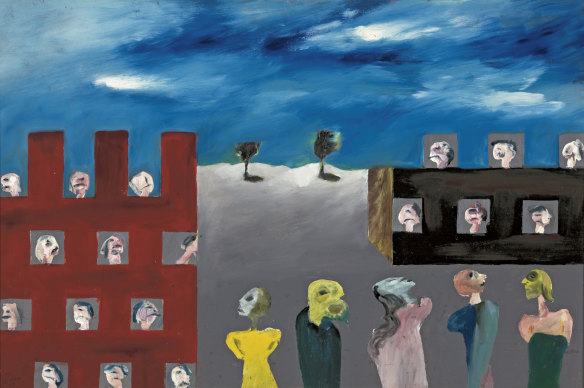
Sidney Nolan, Lublin or Baroque Exterior, 1944. Credit: © Art Gallery of South Australia
As early as 1939, while still living in Melbourne, Nolan first painted the darkness of concentration camps. Prison Camp was brushed over a newspaper photograph of Buchenwald inmates wearing black and white striped uniforms. Nolan recorded his depth of feeling on the back, writing ‘‘Camp ... Tears (St Kilda Beach)’’.
In 1944 he painted Lublin, an image of the Polish city that before World War II had been an important centre of Jewish culture. By the end of the war, the Jewish population had been almost entirely eradicated. The Nazis had established a ghetto within the city limits to house forcibly relocated Jewish and Polish families. Overcrowding, disease and a deliberate policy of starvation sapped their strength as they waited to be shot in the forest or packed shoulder to shoulder in the gas chambers of Majdanek, Sobibor or Belzec.
Nolan’s Lublin featured two buildings pierced by square windows. Each window trapped a single distraught face below or beside a row of chimneys, stark reminders of the crematoria that ringed the city. When he gifted the work to the Art Gallery of South Australia in 1974 Nolan added a second title – Baroque Exterior – the name of an Ern Malley poem whose first lines read: When the hysterical vision strikes/The facade of an era it manifests/Its insidious relations./The windowed eyes gleam with terror.
By June 1955 Nolan was living in London, where he saved several disturbing newspaper articles between pages of his diary. They detailed horrors of the Holocaust that were still being revealed. ‘‘Alleged ‘Bargain’ with Nazis over Hungarian Jews,’’ one headline shouted, describing the collaboration and corruption that had ‘‘filled train after train’’ with 500,000 Jews and sent them to their deaths at Auschwitz. Two years later, on the back of painted heads behind bars, he made himself a note: ‘‘Do European Scene of Camps on scale of Lascaux’’, drawing parallels between prehistoric paintings of extinct animals in the French cave system and the human extinctions of Poland and Germany.
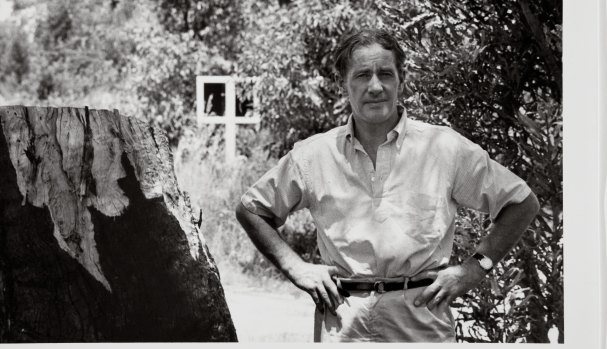
Sidney Nolan in Western Australia in 1962, the year he travelled to Auschwitz. Credit: Collection: National Portrait Gallery, Canberra. © Lisa, Michael, Matthew and Joshua Moore
In early 1961, the capture of one of the Holocaust’s most notorious figures, Adolf Eichmann, provided a catalyst for Nolan’s journey to Auschwitz.
Eichmann had disappeared after the war, but had been tracked to Argentina, where, on May 11, 1960, he was kidnapped by Mossad, the Israeli Intelligence service. He was smuggled back to Israel, accused of crimes against humanity and on April 10, 1961, went on trial in Jerusalem. Israeli television broadcast proceedings live and newspapers around the world ran front-page stories accompanied by photographs of Eichmann sitting behind bulletproof glass.
Nolan was an artist known for celebrating the human spirit, but the trial compelled him to explore man’s lesser nature.
‘‘Al Alvarez comes to lunch,’’ he wrote on July 23, 1961. ‘‘He is going to Poland. We talk about concentration camps. If we could paint the subject it would be a duty to do so.’’ During the Eichmann trial The Observer had asked Alvarez to write on the camps and Nolan was invited to illustrate the article. He made up his mind two weeks later: ‘‘Decide to go to Poland’’, he wrote in his diary.
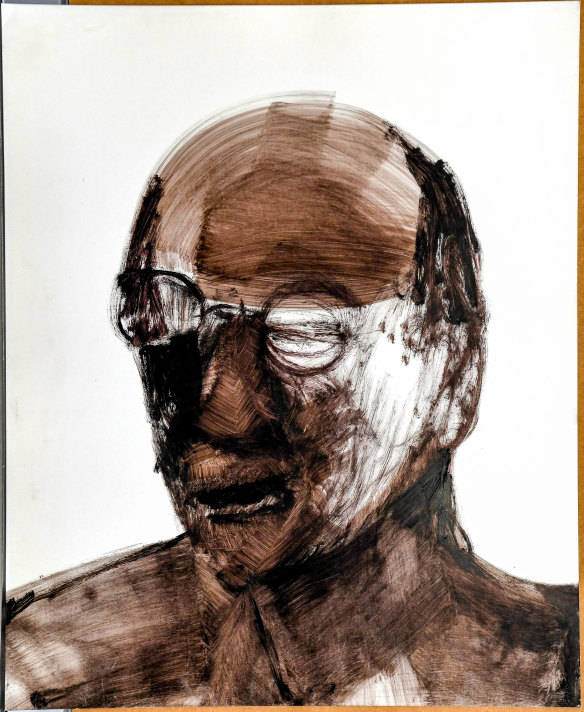
Sidney Nolan, Untitled (Judges and Victims).Credit: Photo: Joe Armao. Original work © The Sidney Nolan Trust. All rights reserved, DACS/Copyright Agency, 2021
For months before the visit, the camps haunted Nolan and he made notes on how he might paint them. Then, between November 27 and December 10, in the two weeks before Eichmann’s judges passed sentence, he filled sheets of paper with the same face and features over and over again – recording ‘‘do 50 today’’ on one day alone. Some were simple outlines, others fully formed, but every image had the same broad forehead, receding hair, thick rounded glasses, thin lips, and in most a collared shirt buttoned to the top. All mirrored photographs of the notorious prisoner.
On December 12, 1961, Eichmann was found guilty of crimes against the Jewish people, crimes against humanity and war crimes. Two days after that, Nolan deliberated, ‘‘I am reluctant in a way to dig deeper into Europe but I do not see how the question of the camps can be forever shelved. Perhaps they will never be the material of art,’’ he wrote. ‘‘It is impossible to tell. How can a disease be painted?’’
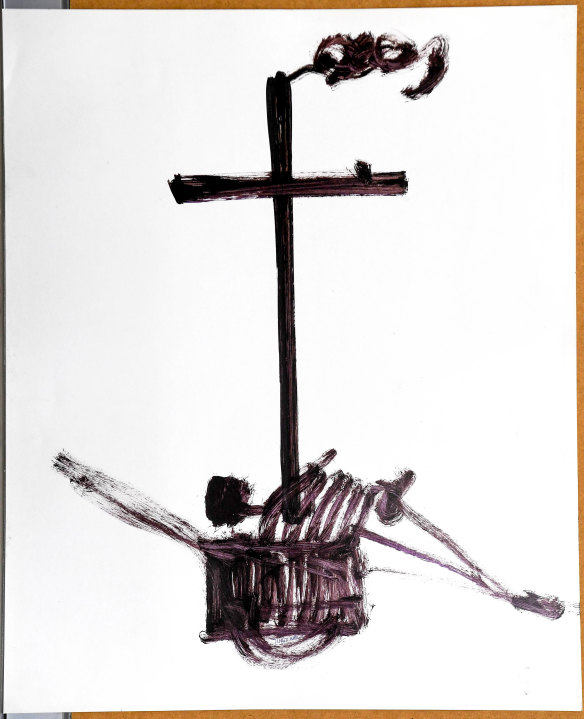
Sidney Nolan, Untitled (Concentration Camp).Credit: Photo: Joe Armao. Original work © The Sidney Nolan Trust. All rights reserved, DACS/Copyright Agency, 2021
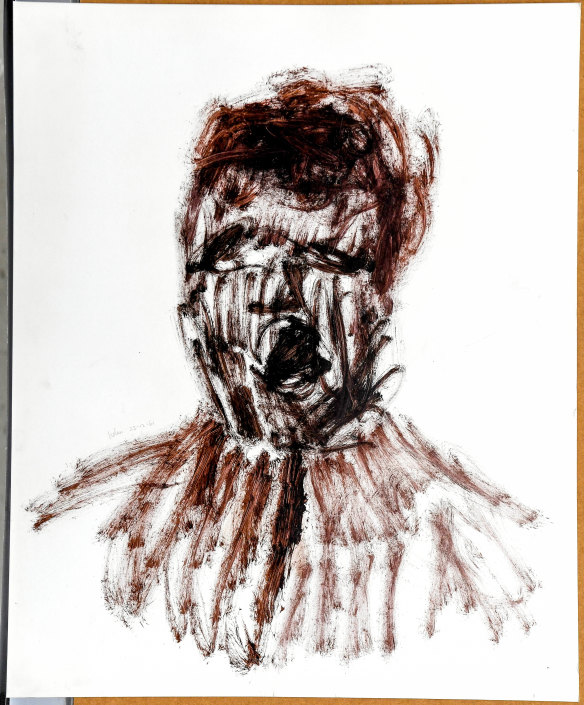
Sidney Nolan, Untitled (Concentration Camp). Credit: Photo: Joe Armao. Original work © The Sidney Nolan Trust. All rights reserved, DACS/Copyright Agency, 2021
The next day Eichmann was sentenced to death and it provided the release Nolan needed. He immediately switched from Eichmann’s face to painting more than a hundred images of Auschwitz and concentration camp inmates, keeping them with the Eichmann portraits in a folder he titled ‘‘Judges and Victims’’. There were three distinct groups, dated roughly six days apart. The first was characterised by prison stripes – faces sliced by bars or vacant eyes above vertical stripes of the camp uniforms. The next group were wreathed in smoke, which suddenly cleared to expose harsh heads scratched from paint with screaming mouths. Finally, there were skeletal heads tortured and twisted. The evolution was clear and their titles unequivocal: Head of Prisoner Concentration Camp and Skeletal Head in a German Concentration Camp.
Nine days passed in peace. Then suddenly more images poured out, a tortured stream of figures crucified on smoking crosses, skeletons overflowing wheelbarrows and bodies laid out in neat rows of death. Nineteen of the pictures were dated January 7, 1962, more than 90 were untitled, and one was reproduced by London’s Marlborough Graphics in 1967. Sidney signed and dated the artist’s proof, inscribing ‘‘Auschwitz’’ on the back.
His iconography was obvious. More than a million human beings became smoke and ash in the Auschwitz ovens. Faith was death and wheelbarrows were for the living to carry the dead to roll call. With an economy of strokes Nolan’s pictures were as convincing as photographs. He found nothing to redeem the human race.
Nolan travelled to Poland with Alvarez two weeks later. On January 29, 1962, he wrote, ‘‘Go to Auschwitz’’. Alvarez recalled: “Auschwitz is a difficult experience to handle, even as a tourist. You grab hold of whatever you can to keep your mental balance.’’ He went on to describe what Nolan saw: ‘‘Mountains of human hair, suitcases, spectacles, shaving brushes, artificial limbs. Great mounds of old shoes reach up like rubble after an air raid’’, all of it covered in dust and human ash, left as though the owners would momentarily return.
In his autobiography, Alvarez remembered that Nolan was ‘‘upset less by the obvious horrors – the crematoria, the mountains of shorn hair, discarded spectacles, suitcases and artificial limbs – than by the orderliness of the camp’s layout’’. He explained: ‘‘The interiors of the barracks were dreadful – the tiers of bunks in which the prisoners slept, six men to a bunk, like battery hens waiting to be slaughtered – but the neat grids in which the buildings were arranged troubled him even more.’’ Turning to Alvarez, Nolan had quietly evoked the disdain his friend and mentor Kenneth Clark had for abstract art and its lack of humanity: ‘‘It looks like a bloody Mondrian,’’ he said.
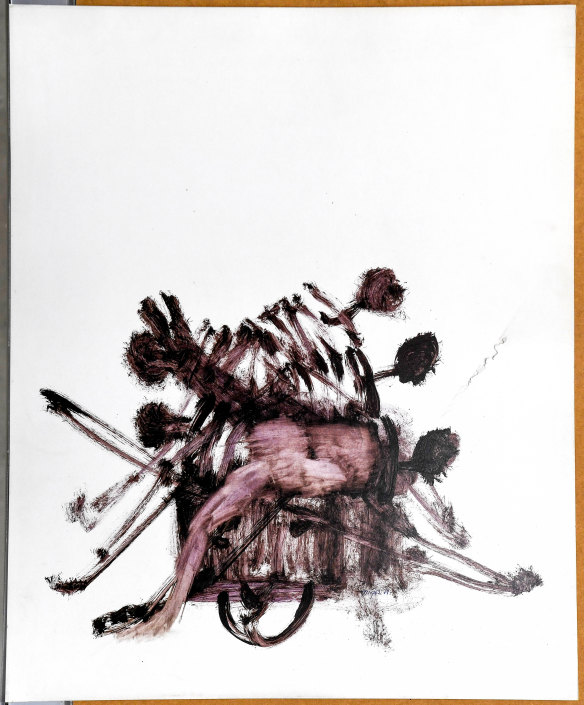
Sidney Nolan, Untitled (Concentration Camp).Credit: Photo: Joe Armao. Original work © The Sidney Nolan Trust. All rights reserved, DACS/Copyright Agency, 2021
Overwhelmed, Nolan refused to illustrate The Observer article. It was an emotional experience for which he had been completely unprepared and the visit triggered an unexpected and lasting retreat from any direct Auschwitz imagery. Unwilling, or even psychologically unable, to translate the experience into paint, he would avoid speaking of it for more than 20 years. Thirty years later he still remembered the disruption it caused to his long-established habit of mixing music and painting, as he wrote in his diary: ‘‘I could not listen to music for months after going to Auschwitz.’’
Alvarez added to Nolan’s emotional turmoil in 1962 by sending a draft of his article. ‘‘Dear Sid,’’ he wrote, ‘‘here’s a draft – much scribbled on. I hope you can make it out. I feel very dissatisfied with it. So do, please, be as ruthless as you can with it. I can’t waste this opportunity to get the thing said straight.’’
In his article, Alvarez suggested that in modern times all humanity had the capability to be inhuman. ‘‘If they [the camps] were simply the playgrounds for sadists who, in another society would have been locked away, then they were an aberration best forgotten, for they prove that our sickest fantasies can be acted out. The Eichmann affair has shown us that they were not.’’
Nolan scrawled on his copy: ‘‘High civilisation can perish; and when the civilisation is a world one, we cannot afford it ... Art has always been a geiger counter for civilisation’’.
Long committed to literature and religion as symbolic languages, Nolan expressed Auschwitz using one to disguise the other. Six weeks after returning he painted an elephant, using the symbol of freedom conjured in Romain Gary’s book The Roots of Heaven. Gary’s lead character, Morel, survived Nazi concentration camps by thinking of elephants. ‘‘I would close my eyes and think of elephants at liberty, running freely across Africa, hundreds and hundreds of magnificent animals that nothing can resist – no cement wall, no barbed wire, nothing ... That’s liberty I tell you!’’ In camps designed to destroy the human spirit ‘‘we came to look at the SS men with smiles,’’ he said, ‘‘as we thought how from one moment to the next, this magnificent charge would pass over them’’.
‘‘Sidney loved elephants,’’ Nolan’s widow, Lady Mary Nolan, confirmed in a 2001 interview with curator and researcher Jane Clark. ‘‘He really did love elephants ... Elephants represented a lot to him.’’
In Gary’s book elephants had represented ‘‘the old human rights, the rights of man’’, and on March 6, 1962, Nolan’s first major painting after his visit to Auschwitz was an elephant straight from Gary’s opening chapter describing ‘‘those noble giants, pressed back more and more towards the marshes and condemned by man to disappear from the earth’’. It was imagery that allowed Nolan to put symbolic flesh on Auschwitz bones.
‘‘You’ve got to belong to a civilisation that’s doomed and express paradise’’ but ‘‘if you have too much of the Nazis you can’t expect to do very well’’, he said in an interview with British art critic Peter Fuller many years later.
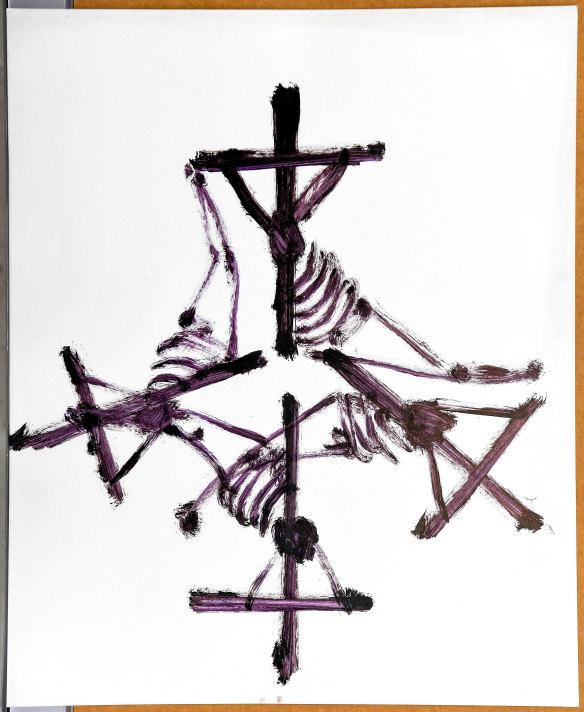
Sidney Nolan, Untitled (Concentration Camp).Credit: Photo: Joe Armao. Original work © The Sidney Nolan Trust. All rights reserved, DACS/Copyright Agency, 2021
From September 1962, Nolan chased visions of paradise during a three-month trip through Africa. But a deep well of grief ran through the resulting work. There were faces and figures of disenfranchised tribes and races, subjugated by colonial empires. He posed apes as ‘‘Ecce Homo’’ – Christian iconography representing the abasement of human beings in war – and floated gorillas in earthen tombs, lamenting, ‘‘He is a better kind of man. He doesn’t make war ... so we kill him off.’’
In 1965, Nolan briefly placed apes and saints on smoking crosses while helmeted Nazis marched beneath or leered at women. Then two years later he revealed to Gavin Souter of the Sydney Morning Herald: ‘‘When I went to Auschwitz I was struck by the enormity of the scandal of the position of women,’’ and then linked Auschwitz to Dante’s Inferno, a nine-panelled painting of female figures ‘‘stacked like firewood in the streets’’, telling Hal Missingham, then director of the Art Gallery of NSW, ‘‘as I painted they levitated ... whirling around in the sky and looked more like ... lost souls’’.
Throughout the ’60s, ’70s and ’80s, Nolan continued to stare into the pit. ‘‘Am I moving towards Austwitz [sic] painting at last?’’ he wrote in 1985. ‘‘I hope not.’’
‘‘He deplored human suffering,’’ his friend of 40 years, George Ivan Smith, recalled at Nolan’s 1993 memorial service. He had raged against human tragedy, Smith said, a painter driven by ‘‘deep respect for life and by deep grief when [he] sensed that life was being crushed in that eternal struggle between the forces of light and darkness’’.
The impact of the Holocaust on Sidney Nolan has remained invisible. But soon after visiting Auschwitz he said, ‘‘What an artist really wants is to say something which one day – out of contemporary context – will mean something important.’’
In a world still troubled by genocide, racial disenfranchisement and nationalism, Nolan’s Holocaust images reflect something he and Alvarez often discussed – the arts ‘‘didn’t just reflect society, they were a kind of early warning system’’. This year, the 60th anniversary of Eichmann’s trial, we are well-positioned to exhume and examine Nolan’s warning. To look back towards the crematoria and barbed wire, and through his exploration of our lesser nature, acknowledge and honour the ghosts pleading to be remembered.
This is an adapted extract from Andrew Turley’s upcoming book, Nolan’s Africa.